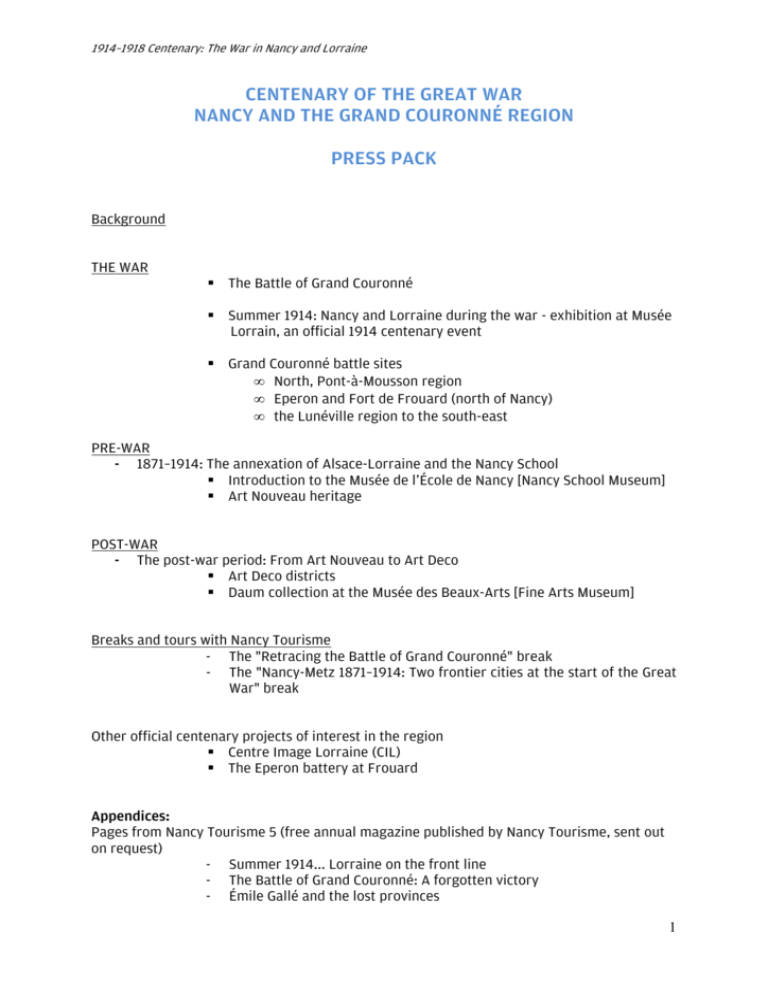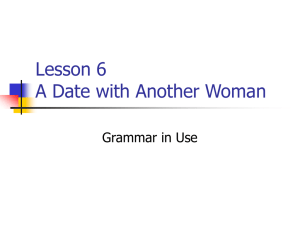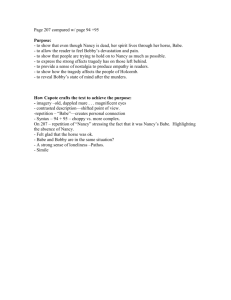DDP EN Centenaire Nancy et la Bataille de Nancy
advertisement

1914–1918 Centenary: The War in Nancy and Lorraine CENTENARY OF THE GREAT WAR NANCY AND THE GRAND COURONNÉ REGION PRESS PACK Background THE WAR The Battle of Grand Couronné Summer 1914: Nancy and Lorraine during the war - exhibition at Musée Lorrain, an official 1914 centenary event Grand Couronné battle sites • North, Pont-à-Mousson region • Eperon and Fort de Frouard (north of Nancy) • the Lunéville region to the south-east PRE-WAR - 1871–1914: The annexation of Alsace-Lorraine and the Nancy School Introduction to the Musée de l’École de Nancy [Nancy School Museum] Art Nouveau heritage POST-WAR - The post-war period: From Art Nouveau to Art Deco Art Deco districts Daum collection at the Musée des Beaux-Arts [Fine Arts Museum] Breaks and tours with Nancy Tourisme - The "Retracing the Battle of Grand Couronné" break - The "Nancy-Metz 1871–1914: Two frontier cities at the start of the Great War" break Other official centenary projects of interest in the region Centre Image Lorraine (CIL) The Eperon battery at Frouard Appendices: Pages from Nancy Tourisme 5 (free annual magazine published by Nancy Tourisme, sent out on request) - Summer 1914... Lorraine on the front line - The Battle of Grand Couronné: A forgotten victory - Émile Gallé and the lost provinces 1 1914–1918 Centenary: The War in Nancy and Lorraine Background Summer 1914: the war in Nancy and Lorraine Located 15 km from the German border following the annexation of Alsace-Moselle in 1871, Nancy and its north-western and eastern environs (Pont-à-Mousson and Lunéville Region, respectively) provided the main setting for the first battles of summer 1914. The Battle of Grand Couronné, named after the local area, played a major role in defending Nancy and its surroundings. It also stabilised the front in this area for the entire duration of the war and prevented the French troops being attacked from the rear during the Battle of the Marne. 1871–1914: The Nancy School Nancy, which was now the only large city in the east of France, rapidly expanded due to a population influx and impressive economic development. This led to the creation of the École de Nancy [the Nancy School], and the city’s status as a European capital of Art Nouveau. The city is home to many impressive examples of Art Nouveau architecture, particularly in the city centre, around the station (Nancy's railway dates back to 1850) and in the western districts, ranging from commercial and financial buildings to private mansions. The Musée de l'École de Nancy [Nancy School Museum], located in the residence of Art Nouveau patron Eugène Corbin, boasts a spectacular collection. Art Deco: The reconstruction Art Deco began to appear at the outset of the war, and was the dominant style of the post-war reconstruction programme. While much of the city's heritage managed to escape relatively unscathed, including the UNESCO world heritage sites, the ducal palace and many private mansions, the bombing did cause some destruction. A number of the post-war reconstruction projects adopted the Art Deco style, including the Majorelle stores, the "Magasins Réunis" stores, the law faculty library and various apartment blocks and houses. 2 1914–1918 Centenary: The War in Nancy and Lorraine THE WAR THE BATTLE OF GRAND COURONNÉ The Grand Couronné is a series of seven hills stretching in a semi-circle from Pont-à-Mousson to Epinal. Following the French defeat at Morhange, the Prussian army went on the offensive and attempted to break through westwards via the "Trouée de Charmes" on the southern front, but was violently pushed back on 24 August 1914. It then attempted an offensive north of Lunéville. The close combat was fierce, with the hill of Léomont changing hands eight times in just one night. There were huge losses. The Grand Couronné had to hold. The French advanced, and Lunéville, which had been occupied since 22 August, was liberated on 12 September. The heroic Battle of Grand Couronné had come to an end. France was victorious. This victory at Grand Couronné was of vital importance, since it gave Marshal Joffre the flexibility he needed to organise and win the first Battle of the Marne (6–12 September 1914). The sacrifice of those young soldiers' lives at Grand Couronné was not in vain: following the battle, the armies dug themselves in and trench warfare began. 3 1914–1918 Centenary: The War in Nancy and Lorraine Exhibition: "Summer 1914: the war in Nancy and Lorraine" th st 15 February to 21 September 2014 Musée Lorrain – Nancy Musée Lorrain, a regional museum of art and history, is organising an exhibition focused on the early days of the war in Lorraine, as part of the First World War commemorations. The exhibition focuses on five key themes: - 1870–1914: An unexpected war? - August 1914: Off for summer... - The battles of Lorraine, summer 1914 - Images and memories of the fighting in summer 1914 - Images and memories of the fighting after the war The exhibition at Musée Lorrain provides an overview of the context in which Lorraine joined the war and the start of the conflict in the region, illustrating why the Battles of Lorraine in 1914 played such an important role in defending France's eastern borders. It therefore focuses on the Battle of Grand Couronné. In addition, the exhibition looks at daily life at the front and behind the lines, primarily through major artists' impressions of the fighting, including members of the Nancy School. It also considers images of Lorraine and the lost provinces of 1870 at the start of the war and their role on both sides of the border during the conflict. The exhibition draws on the museum's own rich and varied collection and on loans from private institutions and collectors. Innovative educational communication tools will ensure that all visitors gain a good understanding of the battle and Lorraine's role in the First World War. In short, this will be a historical, artistic and sociological exhibition that meets the Musée Lorrain's aim of promoting regional history, while considering our relationship to this history, its key issues and the way it is represented in the twenty-first century. 4 1914–1918 Centenary: The War in Nancy and Lorraine The project is part of a collaboration with memorial sites in the region and the battle sites themselves. A number of projects and activities are currently being planned with the relevant communes, particularly those in Grand Couronné, involving both the sites and the museum exhibition. Practical information Musé Musé e Lorrain - Ducal Palace 64 Grande Rue 54000 Nancy France +33 (0)3 83 32 18 74 www.musee-lorrain.nancy.fr 15th February to 21st September 2014 Opening hours 10.00 am to 12.30 pm and 2.00 pm to 6.00 pm, every day except Monday. Closed on 1st May, 14th July. Open Easter Monday and Whit Monday. Ticket prices Ducal Palace: standard €4, concessions €2.50 Church and Cordeliers Convent: standard €3.50, concessions €2 Combined ticket for Ducal Palace and Cordeliers: standard €5.50, concessions €3.50 Pass “6 Museums” :€10 Free entry every first Sunday of the month and for students on Wednesdays. 5 1914–1918 Centenary: The War in Nancy and Lorraine GRAND COURONNÉ BATTLE SITES The Grand Couronné Couronné area is a group of hills surrounding Nancy, stretching from PontPont-àMousson and SainteSainte -Geneviè Genevi è ve in the northnorth-west to the Luné Lunéville region in the southsoutheast. The society Paysages et Sites de M Méémoire de la Grande Guerre [Great War Landscapes and Memorial Sites] is campaigning for three sites in Meurthe and Moselle to be granted UNESCO world heritage status: - Bois le Prê Prê tre near PontPont-à-Mousson (in the northnorth-west) - The hill of Lé Lé omont near Luné Luné ville (in the southsouth-east) - Chapelotte, at the edge of the French department of Vosges. This final site is not considered a Grand Couronné Couronné battle site. 1) North-west area (around Pont-à-Mousson) MAIN SITES - Thiaucourt American military cemetery: Contains the graves of American soldiers, most of whom fell during the great offensive that lead to the reduction of the St Mihiel salient in 1918. Open to groups and individuals (cars and buses), 9.00 am to 5.00 pm. ABMC – +33 (0)3 83 80 01 01 Route de Verdun 54470 Thiaucourt Regnieville On the other side of the same hill Thiaucourt German military cemetery: SESMA – +33 (0)3 29 87 32 76 54470 Thiaucourt Regnieville Musée du Costume Militaire [Museum of Military Uniform] (1900–1950) and the battles of the St Mihiel salient: Fifty years of military history through the uniforms of the French, American and German armies. Houses many rare and unusual items. Opening hours - Every day for groups, subject to reservation. - Thursdays 10.00 am to 4.00 pm + second Sunday of the month, 2.00 pm to 6.00 pm, March to November, for individuals. Musée du Costume Militaire – +33 (0)3 83 81 98 36 4 Rue Neuve 54470 ThiaucourtRegnieville - Trenches between Saint-Baussant and Flirey, along the St Mihiel salient road Leave the village of Saint-Baussant and head towards Flirey, following the signs. The car park is on the left of the road (bus and car). The entrance to the German trench is on the other side of the road; carry on by foot for 100–200 m (follow the signs). Some of the trenches have been restored, with information panels. Open to groups and individuals. 6 1914–1918 Centenary: The War in Nancy and Lorraine - Fey-en-Haye, Grüber stained glass windows Fey-en-Haye is a reconstructed village. The St Gorgon church features stained glass windows by Jacques Grüber on the theme of the Great War, including L’inauguration du monument de la Croix des Carmes [The Inauguration of the Croix des Carmes Monument]. Open to coach parties and individuals. The church is closed. For all visits, please contact Jean-Paul David, Rue de la 73e Division, Feyen-Haye. Tel. +33 (0)6 62 05 60 64. - Reménauville, destroyed village A chapel has been built on the location of this destroyed village. The forest has grown back, but paths have been created along the routes of the old streets, after which they are named. Information panels show before and after photos. Open to coach parties and individuals. Another destroyed village mentioned on one of the panels is Rignéville. All that remains is a church on the edge of the road. - Montauville:Bois-le-Prêtre was the scene of fierce fighting. Croix des Carmes monument, fountain, Father Hilarion's forest house, three walking trails, blockhouse and trenches along the route, Pétant cemetery. The Pétant cemetery contains the graves of French and Allied soldiers and a memorial for prisoners of war who died in captivity in 1939–1945. SECONDARY SITES Bouillonville German military cemetery (11,685 soldiers): on the road out of the village, follow the signs. For individuals only (the site is not accessible by bus and must be reached on foot). French military cemeteries at Noviant-aux-Prés, Lironville (on the road to Limey) and Flirey (road to Bernécourt). Flirey: Village rebuilt by Emile André (architect and member of the Nancy School), plus monuments to the Americans and to the soldiers from the Southern-France town of Nice. Bouxières-sous-Froidmont: The Cross of Fortuné Pouget, the first soldier who died for France, plus German fortifications. Sainte-Geneviève: Monument to the defenders of Grand Couronné. 2) Eperon de Frouard site (north of Nancy) The Eperon de Frouard battery is the most advanced fortification in the Séré de Rivières system, just a few kilometres from the 1871–1914 border. It has a retractable 1890 model Galopin turret for two 155 mm De Bange canon, the only surviving turret of its kind out of the five built in France at that time. Since 2007, the Assocation de Sauvegarde du Patrimoine Fortifié de Frouard (ASPFF; Association to Preserve the Fortified Heritage of Frouard) has been restoring the Eperon battery and the Fort de Frouard. 7 1914–1918 Centenary: The War in Nancy and Lorraine ASPFF offer guided tours on the third Sunday of each month, from April to October. It has also organised a series of events as part of the centenary commemorations. Its "Poilus à Laneuvelotte" [WWI soldiers of Laneuvelotte] project has been officially included in the national centenary programme. The site (from the top of the battery) offers stunning views across the valleys of Moselle, Meurthe and Amezule, some of the Grand Couronné battlefields, Nancy and the Vosges mountains. Contact: +33 (0)3 83 20 41 65 3) Southouth-east area (around Luné Luné ville) Battle of Grand Couronné Couronné trail Léomont hill, Friscati-Mouton Noir national cemetery, Espace Chaubet museum Towards the end of 1914, Marie Marguerite Wibrotte, a teacher living in Lunéville, decided to search for the bodies of dead soldiers so that they could be laid to rest in a grave. In 1916, she purchased the Mouton Noir farm, where she created a memorial chapel for families to come and remember their dead. Its interior is decorated with murals depicting war scenes. The site was later donated to Souvenir Français and the buildings were turned into a museum featuring audiovisual and multimedia exhibitions. The museum opened to the public in June 2007. The cemetery and the museum are testimony to the site's history and the soldiers who fought ceaselessly from 22 August to 12 September 1914. A documentary film featuring archive footage and reconstructions traces the fighting around Lunéville. A clearly marked memorial trail runs between Friscati and the summit of Léomont hill, where the statue of the "Poilu du Léomont" [Soldier of Léomont] is located. The statue is a memorial to the 4000 soldiers who fell on the hillsides of Vitrimont and Friscati during the Battle of Grand Couronné. A viewpoint indicator at the top of the hill where the statue was erected allows visitors to identify the battle field, still visible in today's landscape. Friscati-Mouton Noir National Cemetery Open Wednesday to Sunday, 2.00 pm to 6.00 pm Lunéville Region tourist information: +33 (0)3 83 74 06 55 Espace Chaubet Open 1 May to 11 November, Wednesdays, Saturdays and Sundays, 2.00 pm to 6.00 pm. Open all year round for group and school trips, subject to booking. Espace Chaubet Museum: +33 (0)3 83 74 05 00 54300 Vitrimont Léomont Memorial Opening hours May, June, September, October and up until 15 November: Wednesdays, Saturdays and Sundays, 2.00 pm to 6.00 pm. In July and August, open Wednesday to Sunday, 2.00 pm to 6.00 pm. 8 1914–1918 Centenary: The War in Nancy and Lorraine Contact Weekdays: +33 (0)3 83 74 05 00 Open 8.00 am to 12.00 pm and 1.30 pm to 5.30 pm. Weekends: +33 (0)6 08 40 77 47 Other sites in the south/south-east area Entonnoirs de Leintrey: Craters 60 m in diameter and 15 to 20 m deep caused by German mines that exploded during the night of 10–11 July 1916. Lunéville Region tourist information +33 (0)3 83 74 06 55 54450 Leintrey French and German war cemeteries at Gerbeviller: The town, also known as Gerbeviller the Martyr, was destroyed in retaliation for the failure to take the Mortagne bridge. Crown Prince's Bunker: Prince Wilhelm of Prussia's command bunker. Lunéville Region tourist information +33 (0)3 83 74 06 55 54370 Emberménil 9 1914–1918 Centenary: The War in Nancy and Lorraine PRE-WAR 1871–1914: The annexation of Alsace-Lorraine and the Nancy School Towards the end of the nineteenth century, European decorative arts adopted an entirely new formal approach. In Nancy, Art Nouveau gained rapid ground and the Lorraine capital played a major role in this artistic movement. The city's dynamism, enthusiasm and passion owed much to the young, often wealthy and well educated population, who had been exiled from Alsace and northern Lorraine following the regions' annexation by Germany in 1871 as part of the Treaty of Frankfurt. Daum, Wiener and Weissenburger were among those who made their home in Nancy. The city of Nancy was occupied by Germany until 1874. It then experienced an economic and demographic explosion, due to an influx of residents from Alsace and Moselle who chose to retain their French nationality by leaving the regions annexed by Germany. However, the city faced serious challenges as a result of this rapid urban development. 1911 saw its population rise to 120,000 due also to the recovery of the University of Strasbourg from the Germans (the medical faculty and school of pharmacy had been transferred in 1872). As the closest city to Prussia, Nancy had to become a showcase for France, and Prussia developed Metz for the same reason. In Nancy, the worlds of art and industry came together, and the "minor" arts of glasswork, ceramics, metalwork, stained glass, woodwork and the like became a major feature of everyday life. Nancy's impressive economic development gave a boost to Lorraine's artists and, within a few years, the region's capital had become a focal point for French decorative arts. Regional artists aimed to promote the so-called "minor" arts in order to break down the rigid division separating them from the "major" arts of architecture, painting and sculpture. They also focused on furniture, jewellery and decorative objects, in an effort to place "art in everything" while creating "art for all": producing and distributing works of art in large numbers of copies. In 1901, Émile Gallé founded the Alliance Provinciale des Industries d’Art (l'École de Nancy) [the Provincial Alliance of Artistic Industries (also called the Nancy School)] with artists and industrialists including Daum, Prouvé, Majorelle, Vallin, Grüber and Muller. Many of the Nancy School artists wanted to see Alsace and Moselle returned to France, and this desire was reflected in the creation of bold, symbolic works. 10 1914–1918 Centenary: The War in Nancy and Lorraine Gallé's work in particular embodied this concern. The artist supported not only the return of the provinces lost to Prussia, but also Captain Alfred Dreyfus, and he was opposed to the massacre of the Armenians. Gallé also adopted a progressive social policy in his factory on Avenue de la Garenne, which employed as many as 400 workers. Émile Gallé - Rosa Gallica (Vase Rose de France) Musée de l’École de Nancy / The Nancy School 1) Musée de l’École de Nancy [Nancy School Museum] Located in the former home of Eugène Corbin, which was acquired by the city in 1951–1952, the Musée de l’École de Nancy enjoys an architectural environment dating back to the same period as the works on display. From 1890, Eugène Corbin, the owner of the Magasins Réunis stores, was a generous patron of the Nancy School artists. He significantly boosted the movement's reputation and helped spread the School's ideas and works. Despite significant development in the district, much of the property's garden still exists today. It was restored in 1999 to reflect its former planting at the turn of the century. Collections The collections reflect the diversity of techniques used by the Nancy School artists (furniture, decorative objects, glasswork, stained glass, leather, ceramics, textiles etc.) and recreate the atmosphere of the period. Almost the entirety of the Masson dining room, created by Eugène Vallin, is on display. Other unique, luxury items can also be seen, including the "Dawn and Dusk" bed and the "Le Rhin" table by Émile Gallé, the Villa Majorelle bedroom and the "Death of the Swan" piano by Louis Majorelle. 11 1914–1918 Centenary: The War in Nancy and Lorraine A stunning collection of Émile Gallé glasswork reflects the movement's technical prowess and the inspiration it took from nature. Villa Majorelle Villa Majorelle can be visited as part of an individual guided tour organised by the Musée de l'École de Nancy, at 1.45 pm and 3.00 pm on Saturdays and Sundays. Reservation is mandatory. Contact the Musé Musé e de l’É l’ É cole de Nancy for bookings and information. Tel.: +33 (0)3 83 40 14 86 (max. 18 people for the tour). Practical information Musé Musé e de l'É l'É cole de Nancy 36–38 Rue du Sergent Blandan 54000 Nancy France +33 (0)3 83 40 14 86 http://www.ecole-de-nancy.com/web/ Opening hours Wednesday to Sunday, 10.00 am to 6.00 pm (closed all day Monday and Tuesday). Closed 1 January, 1 May, 14 July, 1 November, 25 December Ticket prices (ticket valid for whole day) - Standard €6 - Concessions €4 - Pass “6 museums” €10 12 1914–1918 Centenary: The War in Nancy and Lorraine NANCY'S ART NOUVEAU HERITAGE 1901 marked not only the official creation of the Nancy School (Alliance Provinciale des Industries d’Art [Provincial Alliance of Artistic Industries]), but the start of Art Nouveau's influence on Nancy's architecture. From the construction of Villa Majorelle to the modernisation of the city centre and the design of the Parc de Saurupt subdivision, Nancy's entire urban landscape was extensively and indelibly marked by Art Nouveau. The Nancy School left a stunning heritage that can be explored by simply strolling through the city's streets and districts. This architectural wealth is on show across the city, in the banks and stores between the station and the "Point Central" at the crossroads of the Saint Dizier and Saint Jean shopping streets; the Parc de Saurupt garden suburb created by Jules Villard in 1901; the western districts around Parc Sainte Marie and the Musée de l'École de Nancy; and the central station area, with its private mansions along the railway and grand apartment blocks on Avenue Foch and Rue de la Commanderie. The Musée de l'École de Nancy, located in the former home of the arts patron Eugène Corbin, now boasts one of the most beautiful collections of Art Nouveau in the world (see pages 12 and 13). Nancy Tourisme et Evénements organises Art Nouveau tours All year round: Audio guides in French, English, German and Japanese. Duration: Two to four hours' walk. €7,5 per person and €100 deposit per audio guide. In high season: Guided walking tours. Find out more on the Nancy Tourisme et Evénements website or by calling +33 (0)3 83 35 22 41. 13 1914–1918 Centenary: The War in Nancy and Lorraine THE POST-WAR PERIOD From Art Nouveau to Art Deco Art Nouveau and Art Deco: the two styles are often confused, as one followed the other. And yet, although much of the interest of this key period lies in analysing the overlap between the two styles, we can easily see how quickly Art Deco moved away from the characteristics of Art Nouveau. The styles referred to as Art Nouveau emerged and developed more or less worldwide from the 1880s, forming neighbouring if not sister schools. The Art Nouveau movement in Nancy was born from the annexation of Alsace and Moselle by the Kaiser in 1871. Nancy, which thus became a French border city, gave refuge to large numbers of intellectuals who refused to submit to the annexation. These unique conditions and the influx of artists, industrialists and entrepreneurs gave rise to the Nancy School. The movement weakened with the death of Emile Gallé in 1904, the Great War is seen as marking its end. The Art Deco style developed in Nancy between the wars, relatively late compared with countries that were not directly affected by the 1914-18 conflict. The Nancy School subdivision of districts, interrupted by the war in 1914, was resumed during the 1920s. This is why Art Nouveau and Art Deco villas can be found side by side in areas such as Saurupt and Nancy Thermal. The region’s architects evolved, adopting the more geometric, more "modern" style. Art Deco: The reconstruction The richness of Nancy’s Art Deco heritage is rare in France, and includes architecture, glasswork, stained glass and metalwork. After the First World War, Nancy retained the reputation it had acquired during the days of the Nancy School as an artistic centre. Building on the success of the Nancy School, the city was able to develop its industry and education in the applied arts. In 1916, Jean Prouvé, son of Victor Prouvé, trained as a craftsman metalworker and went on to become one of the most important manufacturers and leading designers of the twentieth century. His output between the two world wars can be spotted throughout the city centre and includes gates, railings and doors, as well as furniture for locations such as the Montbois university campus and the university library in Place Carnot. The Musée des Beaux-Arts de Nancy [Nancy Museum of Fine Arts] opened a new gallery in 2012 devoted entirely to this talented resident of the city. However, Jean Prouvé is not the only artist to have contributed to the development of Art Deco in Nancy: from Oudeville and Mascret to Masson and Criqui, 14 1914–1918 Centenary: The War in Nancy and Lorraine there is a long list of Art Deco architects who made a lasting mark on Nancy between the wars, producing religious and public buildings, apartment blocks and private homes. Whole districts changed in character, including the unique Saurupt neighbourhood, where stunning buildings from the two eras exist side by side. Despite its impressive Art Nouveau homes, Saurupt was a commercial failure in the pre-war period. Subdivision work resumed in the 1920s, creating smaller plots of land, and the area was soon covered with Art Deco buildings, the most well-known of which is Villa les Cigognes. Even outside the confines of Parc de Saurupt, the entire district and part of Rue du Maréchal Oudinot owes a debt to Art Deco. Nancy Tourisme offers Art Nouveau/Art Deco tours throughout summer. Contact Nancy Tourisme et Evénements for more information. www.nancy-tourisme.fr Tel.: +33 (0)3 83 35 22 41 The Daum collection at the Musée des Beaux-Arts: a perfect example of the transition from Art Nouveau to Art Deco This collection of Daum glasswork is presented in a unique setting, allowing visitors to explore 100 years of production from this famous Nancy manufacturer. The transition from the Nancy School to Art Deco is particularly evident in the changes in the prestigious crystal studio's output. Practical information Musé Musée des BeauxBeaux- Arts 3 place Stanislas 54000 NANCY 03 83 85 30 72 http://mban.nancy.fr/ Opening hours: hours: 10 am to 6 pm except Tuesdays. Closed: Closed : 1 January, 1 May, 14 July, 1 November, 25 December. Prices: Prices: Standard: €6 Concessions: €4 Pass “6 museums”: €10 Guided tours: €1.60 in addition to the entry ticket Free entry for all on the first Sunday of every month and for students on Wednesdays 15 1914–1918 Centenary: The War in Nancy and Lorraine BREAKS AND TOURS FROM NANCY TOURISME ET EVENEMENTS Nancy Tourisme et Evénements offers three tourist breaks, each available for both individuals and groups: - The Retracing the Battle of Grand Couronné break The From Nancy to Verdun break The Nancy-Metz 1871-1914: two frontier cities at the start of the Great War break The Nancy-Metz break is organised in collaboration with the Metz Tourist Office, as well as the Nancy-Verdun break with partners in Verdun Other packages are also being developed, covering a wider geographical area. Groups Department Annabelle HAEBIG service.groupes@nancy-tourisme.fr Direct line 03 83 35 90 02 16 1914–1918 Centenary: The War in Nancy and Lorraine The Retracing the Battle of Grand Couronné break for groups 17 1914–1918 Centenary: The War in Nancy and Lorraine The Retracing the Battle of Grand Couronné break for individuals 18 1914–1918 Centenary: The War in Nancy and Lorraine The From Nancy to Verdun break for grouos 19 1914–1918 Centenary: The War in Nancy and Lorraine The Nancy-Metz 1871-1914: two frontier cities at the start of the Great War break for groups 20 1914–1918 Centenary: The War in Nancy and Lorraine The Nancy-Metz 1871-1914: two frontier cities at the start of the Great War break for individuals 21 1914–1918 Centenary: The War in Nancy and Lorraine OTHER OFFICIAL CENTENARY PROJECTS There are many other official centenary projects selected by the Centenary Mission (a public interest group bringing together seven government ministries, headed up by the Ministry of War Veterans) for inclusion in the official programme to be published at the end of 2013. In addition to the exhibition at the Musée Lorrain in Nancy, and the project organised by the Association de Sauvegarde du Patrimoine Fortifié de Frouard (ASPFF; Association to Preserve the Fortified Heritage of Frouard) (see "Grand Couronné battle sites"), the website www.imagesde14-18.fr, created by the Centre Image Lorraine (CIL), is worth a mention, since it boasts an impressive collection of photos and films from the first world war. The Centre Image Lorraine, formerly the Conservatoire Régional de l'Image (CRI), is an archive centre specialising in film and audiovisual production. It is located in Nancy, in Lorraine. Centre Image Lorraine 9 Rue Maréchal Ney 54000 Nancy France Tel.: +33 (0)3 83 32 74 73 / Fax: +33 (0)3 83 32 78 12 22 1914–1918 Centenary: The War in Nancy and Lorraine Press pack appendices: Pages from Nancy Tourisme 5 (free annual magazine published by Nancy Tourisme, sent out on request) - Summer 1914... Lorraine on the front line - The Battle of Grand Couronné: A forgotten victory - Émile Gallé and the lost provinces - 1871–1914: Liberty guiding the Arts Press contact: Nancy Tourisme et Evénements Place Stanislas BP 810 54011 Nancy cedex www.nancy-tourisme.fr Press contact: Florence Dossmann florence.dossmann@nancy-tourisme.fr Tel.: +33 (0)3 83 35 90 03 23





